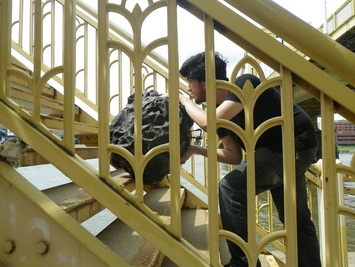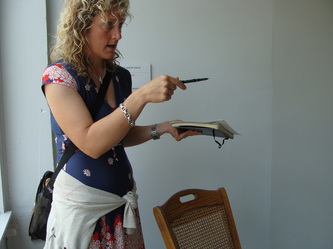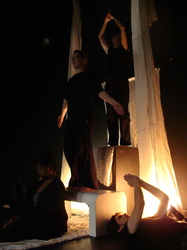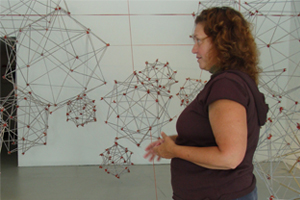 practicing street performance during the Pittsburgh workshop
practicing street performance during the Pittsburgh workshop I walk into the dark theater on 937 Liberty Avenue and see nothing but the black outlines of auditorium seats. It smells like wood and the rain from outside with a hint of Indian food, which I believe one of the artists brought in. There is no one around, so I take a seat and relax. Slowly, one by one, artists of all sorts begin to make their way into the theater, each enthusiastically introducing themselves to me.
To me, an outsider just beginning to establish a connection with the project, it seems like the first workshop; however, it is the third in a series of three. The first workshop was held in Egypt in August of 2010, before the revolution. The second workshop was held, also in Egypt, in March 2011, during the revolution. And the final workshop, which I was lucky enough to attend, was held in Pittsburgh from May 14-22 2011 from 1-7 p.m., post revolution.
As I begin to learn the names of these artists, I ask them simple questions about the workshop trying to get a feel for what they have been involved in. One artist tells me they began inside, at the Bricolage Theater in downtown Pittsburgh, building trust through games that may seem silly to an outside viewer. Once trust was established between the artists, they took their work outside to Phipps Conservatory, the Carnegie Mellon University campus, the streets of Braddock and downtown Pittsburgh, and our cities very own bridges. They simply use the city of Pittsburgh as a landscape for their art, in this case, performance art.
These workshops act as a metaphorical tunnel because, “the commonality between artists on both sides of the tunnel, [in Egypt and in Pittsburgh] is that they’ve done this intensive workshop with me” explains Director Tavia La Follette. The workshops help to build trust between the artists while simultaneously producing a language of peace.
To me, an outsider just beginning to establish a connection with the project, it seems like the first workshop; however, it is the third in a series of three. The first workshop was held in Egypt in August of 2010, before the revolution. The second workshop was held, also in Egypt, in March 2011, during the revolution. And the final workshop, which I was lucky enough to attend, was held in Pittsburgh from May 14-22 2011 from 1-7 p.m., post revolution.
As I begin to learn the names of these artists, I ask them simple questions about the workshop trying to get a feel for what they have been involved in. One artist tells me they began inside, at the Bricolage Theater in downtown Pittsburgh, building trust through games that may seem silly to an outside viewer. Once trust was established between the artists, they took their work outside to Phipps Conservatory, the Carnegie Mellon University campus, the streets of Braddock and downtown Pittsburgh, and our cities very own bridges. They simply use the city of Pittsburgh as a landscape for their art, in this case, performance art.
These workshops act as a metaphorical tunnel because, “the commonality between artists on both sides of the tunnel, [in Egypt and in Pittsburgh] is that they’ve done this intensive workshop with me” explains Director Tavia La Follette. The workshops help to build trust between the artists while simultaneously producing a language of peace.
One of the artists/art curators in the workshop was Katherine Talcott, a contracted curator who is known locally for working with the Three Rivers Arts festival, The Mattress Factory, Museum, Fe Gallery, and the Pittsburgh Center for the Arts. Once trust was built, the tunnel was opened for communication, Katherine and Tavia invited me to attend the first walk through of the space in the Mattress Factory annex. We walked through each room and looked at the dimensions and the overall space to begin a conversation about which peaces would look right in which rooms. Once I attended this walk through the parallel between the importance of movement in the workshops and the importance of movement between rooms in the exhibit space was made clear.
Story by Sarah Weiskopf (sweiskop @ skidmore.edu)
To view more photos from recent workshops visit our VISION page.
For more information about the video artist, Justin Salomone go to www.jaggedserenity.com
To view more photos from recent workshops visit our VISION page.
For more information about the video artist, Justin Salomone go to www.jaggedserenity.com



 RSS Feed
RSS Feed